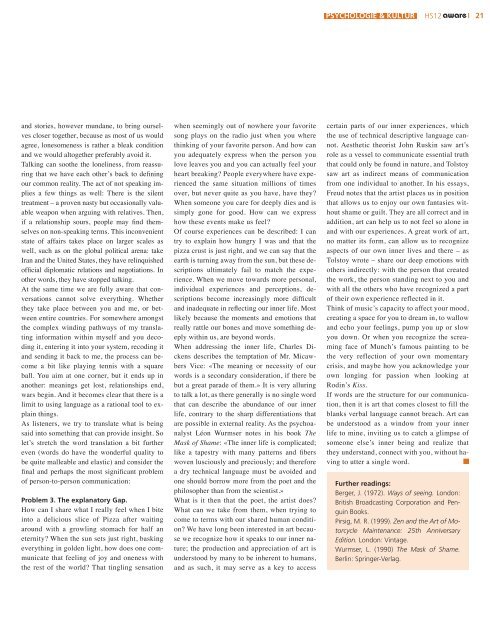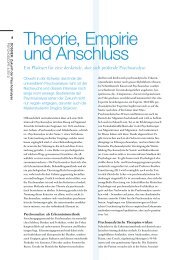Psychologie und Sprache - aware – Magazin für Psychologie
Psychologie und Sprache - aware – Magazin für Psychologie
Psychologie und Sprache - aware – Magazin für Psychologie
Erfolgreiche ePaper selbst erstellen
Machen Sie aus Ihren PDF Publikationen ein blätterbares Flipbook mit unserer einzigartigen Google optimierten e-Paper Software.
and stories, however m<strong>und</strong>ane, to bring ourselves<br />
closer together, because as most of us would<br />
agree, lonesomeness is rather a bleak condition<br />
and we would altogether preferably avoid it.<br />
Talking can soothe the loneliness, from reassuring<br />
that we have each other’s back to defining<br />
our common reality. The act of not speaking implies<br />
a few things as well: There is the silent<br />
treatment <strong>–</strong> a proven nasty but occasionally valuable<br />
weapon when arguing with relatives. Then,<br />
if a relationship sours, people may find themselves<br />
on non-speaking terms. This inconvenient<br />
state of affairs takes place on larger scales as<br />
well, such as on the global political arena: take<br />
Iran and the United States, they have relinquished<br />
official diplomatic relations and negotiations. In<br />
other words, they have stopped talking.<br />
At the same time we are fully <strong>aware</strong> that conversations<br />
cannot solve everything. Whether<br />
they take place between you and me, or between<br />
entire countries. For somewhere amongst<br />
the complex winding pathways of my translating<br />
information within myself and you decoding<br />
it, entering it into your system, recoding it<br />
and sending it back to me, the process can become<br />
a bit like playing tennis with a square<br />
ball. You aim at one corner, but it ends up in<br />
another: meanings get lost, relationships end,<br />
wars begin. And it becomes clear that there is a<br />
limit to using language as a rational tool to explain<br />
things.<br />
As listeners, we try to translate what is being<br />
said into something that can provide insight. So<br />
let’s stretch the word translation a bit further<br />
even (words do have the wonderful quality to<br />
be quite malleable and elastic) and consider the<br />
final and perhaps the most significant problem<br />
of person-to-person communication:<br />
Problem 3. The explanatory Gap.<br />
How can I share what I really feel when I bite<br />
into a delicious slice of Pizza after waiting<br />
aro<strong>und</strong> with a growling stomach for half an<br />
eternity? When the sun sets just right, basking<br />
everything in golden light, how does one communicate<br />
that feeling of joy and oneness with<br />
the rest of the world? That tingling sensation<br />
when seemingly out of nowhere your favorite<br />
song plays on the radio just when you where<br />
thinking of your favorite person. And how can<br />
you adequately express when the person you<br />
love leaves you and you can actually feel your<br />
heart breaking? People everywhere have experienced<br />
the same situation millions of times<br />
over, but never quite as you have, have they?<br />
When someone you care for deeply dies and is<br />
simply gone for good. How can we express<br />
how these events make us feel?<br />
Of course experiences can be described: I can<br />
try to explain how hungry I was and that the<br />
pizza crust is just right, and we can say that the<br />
earth is turning away from the sun, but these descriptions<br />
ultimately fail to match the experience.<br />
When we move towards more personal,<br />
individual experiences and perceptions, descriptions<br />
become increasingly more difficult<br />
and inadequate in reflecting our inner life. Most<br />
likely because the moments and emotions that<br />
really rattle our bones and move something deeply<br />
within us, are beyond words.<br />
When addressing the inner life, Charles Dickens<br />
describes the temptation of Mr. Micawbers<br />
Vice: «The meaning or necessity of our<br />
words is a secondary consideration, if there be<br />
but a great parade of them.» It is very alluring<br />
to talk a lot, as there generally is no single word<br />
that can describe the ab<strong>und</strong>ance of our inner<br />
life, contrary to the sharp differentiations that<br />
are possible in external reality. As the psychoanalyst<br />
Léon Wurmser notes in his book The<br />
Mask of Shame: «The inner life is complicated;<br />
like a tapestry with many patterns and fibers<br />
woven lusciously and preciously; and therefore<br />
a dry technical language must be avoided and<br />
one should borrow more from the poet and the<br />
philosopher than from the scientist.»<br />
What is it then that the poet, the artist does?<br />
What can we take from them, when trying to<br />
come to terms with our shared human condition?<br />
We have long been interested in art because<br />
we recognize how it speaks to our inner nature;<br />
the production and appreciation of art is<br />
<strong>und</strong>erstood by many to be inherent to humans,<br />
and as such, it may serve as a key to access<br />
PSYCHOLOGIE & KULTUR<br />
HS12<strong>aware</strong> 21<br />
certain parts of our inner experiences, which<br />
the use of technical descriptive language cannot.<br />
Aesthetic theorist John Ruskin saw art’s<br />
role as a vessel to communicate essential truth<br />
that could only be fo<strong>und</strong> in nature, and Tolstoy<br />
saw art as indirect means of communication<br />
from one individual to another. In his essays,<br />
Freud notes that the artist places us in position<br />
that allows us to enjoy our own fantasies without<br />
shame or guilt. They are all correct and in<br />
addition, art can help us to not feel so alone in<br />
and with our experiences. A great work of art,<br />
no matter its form, can allow us to recognize<br />
aspects of our own inner lives and there <strong>–</strong> as<br />
Tolstoy wrote <strong>–</strong> share our deep emotions with<br />
others indirectly: with the person that created<br />
the work, the person standing next to you and<br />
with all the others who have recognized a part<br />
of their own experience reflected in it.<br />
Think of music’s capacity to affect your mood,<br />
creating a space for you to dream in, to wallow<br />
and echo your feelings, pump you up or slow<br />
you down. Or when you recognize the screaming<br />
face of Munch’s famous painting to be<br />
the very reflection of your own momentary<br />
crisis, and maybe how you acknowledge your<br />
own longing for passion when looking at<br />
Rodin’s Kiss.<br />
If words are the structure for our communication,<br />
then it is art that comes closest to fill the<br />
blanks verbal language cannot breach. Art can<br />
be <strong>und</strong>erstood as a window from your inner<br />
life to mine, inviting us to catch a glimpse of<br />
someone else’s inner being and realize that<br />
they <strong>und</strong>erstand, connect with you, without having<br />
to utter a single word.<br />
Further readings:<br />
Berger, J. (1972). Ways of seeing. London:<br />
British Broadcasting Corporation and Penguin<br />
Books.<br />
Pirsig, M. R. (1999). Zen and the Art of Motorcycle<br />
Maintenance: 25th Anniversary<br />
Edition. London: Vintage.<br />
Wurmser, L. (1990) The Mask of Shame.<br />
Berlin: Springer-Verlag.










